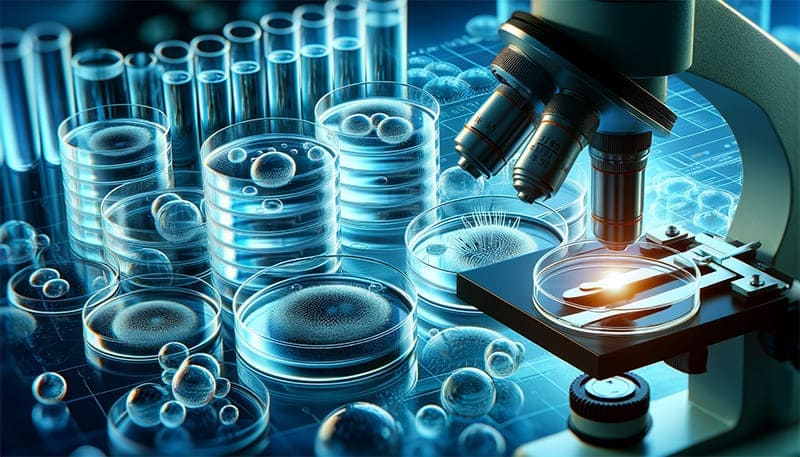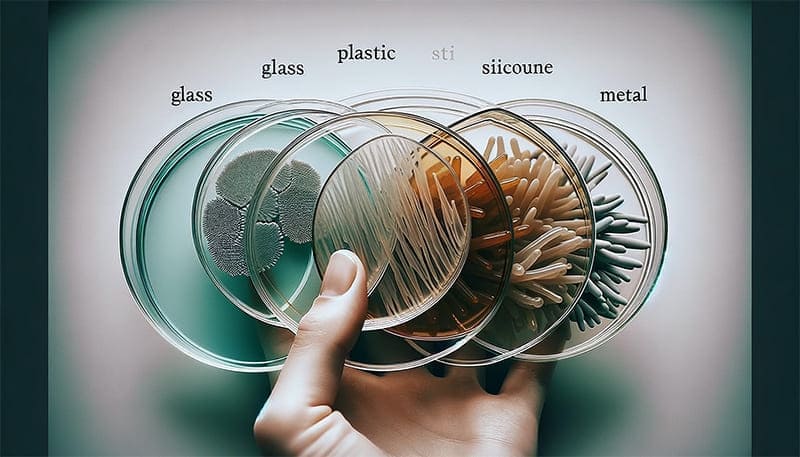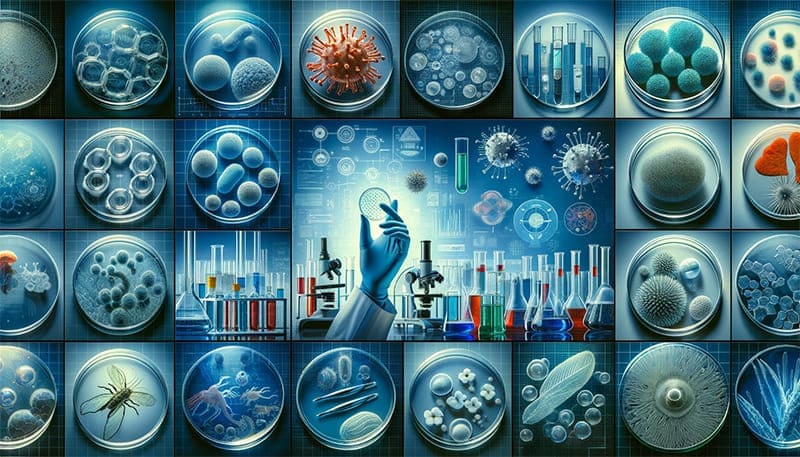Have you ever wondered how the simplest tools in your lab can significantly impact your research outcomes? Picture a typical laboratory setup. What’s the one item you’ll always find? Yes, Petri dishes. But not just any Petri dishes, specifically glass Petri dishes. Why are these seemingly mundane objects revolutionizing lab techniques across the globe?
Glass petri dishes are not just a laboratory staple; they are revolutionary tools that have reshaped our understanding of biology and chemistry. Their ability to withstand various chemicals, maintain sterility, and provide a clear view of their contents makes them invaluable. They play a crucial role in experiments ranging from microbial cultures to cell biology.
Maintaining the integrity of your lab work is crucial, and glass petri dishes are key in achieving this.

Why Are Glass Petri Dishes Essential in Laboratories
Durability and Reusability: Unlike plastic Petri dishes, glass ones can withstand high temperatures and harsh chemicals, making them reusable after proper sterilization. This not only reduces waste but also saves costs in the long run.
Chemical Inertness: Glass does not react with most chemicals or harbor contaminants, ensuring the integrity of your experiments. This characteristic is crucial, especially in sensitive experiments where even the slightest contamination can skew results.
Transparency for Microscopy: The clear nature of glass allows for easy observation under a microscope. This transparency is vital for detailed study of cultures and microorganisms.
How Do Glass Petri Dishes Enhance Lab Techniques
Improved Accuracy: The non-reactive property of glass ensures that there’s no interference with the sample. This leads to more accurate and reliable results.
Environmental Impact: By choosing reusable glass Petri dishes, laboratories contribute to reducing plastic waste, thus having a positive environmental impact.
Cost-Effectiveness: Although the initial cost might be higher than plastic alternatives, glass Petri dishes can be sterilized and reused numerous times, making them a cost-effective solution in the long term.

Comprehensive Comparison: Glass Petri Dishes vs. Other Materials
Understanding the advantages of glass Petri dishes becomes clearer when we compare them with alternative materials like plastic, silicone, and metal. This detailed comparison highlights the unique properties of glass that make it a preferred choice in laboratory settings.
| Material | Glass | Plastic | Silicone | Metal |
|---|---|---|---|---|
| Durability | High – resistant to breakage and can withstand repeated sterilization. | Low to moderate – prone to scratches and can degrade over time. | Moderate – durable but can be prone to tearing. | High – very durable but can corrode over time. |
| Chemical Resistance | High – does not react with most chemicals. | Low to moderate – can react with certain chemicals and prone to staining. | High – generally resistant to most chemicals. | Varies – depends on the type of metal, some may react with specific chemicals. |
| Heat Resistance | High – can withstand high temperatures without deforming. | Low – prone to melting or deforming at high temperatures. | High – maintains properties at a wide range of temperatures. | High – generally good heat resistance. |
| Transparency | High – allows for clear observation under a microscope. | Low to moderate – can become cloudy over time. | Low – generally opaque, hindering observation. | None – opaque, not suitable for microscopic observation. |
| Reusability | High – can be sterilized and reused multiple times. | Low – often designed for single use due to degradation. | Moderate – can be reused but not as durable as glass. | Moderate to high – can be reused but requires careful maintenance to prevent corrosion. |
| Environmental Impact | Low – reusable and reduces waste. | High – contributes significantly to plastic waste. | Moderate – less waste than plastic but more than glass. | Moderate – durable but production and disposal can be environmentally intensive. |
This comparison clearly shows that glass Petri dishes are superior in several key aspects: durability, chemical resistance, transparency for observation, and environmental impact. While alternative materials may offer certain advantages in specific scenarios, glass stands out as the most versatile and reliable option for a wide range of laboratory applications.

Versatile Applications: The Diverse Uses of Petri Dishes in Scientific Research
A crucial aspect of understanding the significance of glass Petri dishes lies in exploring their varied applications in laboratory environments. Petri dishes are not just limited to a single type of experiment; their uses span a wide range of scientific disciplines and techniques.
Microbiological Cultures: One of the most common uses of Petri dishes is in culturing microorganisms. Researchers grow bacteria, fungi, and other microorganisms on various growth mediums in Petri dishes to study their characteristics, behavior, and response to different conditions.
Cell Culture Studies: In cell biology, Petri dishes provide an ideal environment for growing and observing animal and plant cells. This is crucial for research in genetics, medicine, and pharmacology, where understanding cell behavior is fundamental.
Antibiotic Sensitivity Testing: In medical laboratories, Petri dishes are used for antibiotic sensitivity tests. This involves growing bacteria on a dish and introducing different antibiotics to see which ones effectively kill or inhibit the bacteria, which is crucial for treating infections.
Environmental Sampling: Scientists use Petri dishes to collect environmental samples like air, water, or soil for contamination analysis. They allow for the controlled growth of organisms present in these samples, aiding in environmental monitoring and research.
Educational Demonstrations: In educational settings, Petri dishes are used for teaching basic principles of microbiology and cell biology. They provide a clear, contained environment for students to observe and learn about various biological processes.
Quality Control in Food Industry: The food industry frequently uses Petri dishes for quality control, testing products for microbial contamination to ensure safety and compliance with health standards.

Revolutionizing Research: Unveiling the Pivotal Role of Glass Petri Dishes in Modern Labs
In the intricate world of scientific exploration, the impact of fundamental tools is often underestimated. Glass Petri dishes, a staple in laboratories worldwide, are more than mere vessels; they are a key to unlocking higher precision and reliability in research. This article explores the multifaceted advantages of glass Petri dishes, highlighting their essential role in enhancing advanced imaging, maintaining sterility, and enriching educational lab experiences. Join us as we uncover how these simple yet powerful tools are reshaping the landscape of scientific research.
Enhancing Advanced Imaging Techniques with Glass Petri Dishes
Advanced Imaging Techniques with Glass Petri Dishes: The clarity and durability of glass Petri dishes play a pivotal role in advanced imaging techniques like fluorescence microscopy or high-resolution scanning. The superior transparency of glass allows for unobstructed light transmission, which is crucial for high-quality imaging. Furthermore, their resistance to high temperatures and chemicals ensures that glass dishes maintain their integrity under various imaging conditions. This combination of clarity and durability not only improves the accuracy of imaging results but also expands the capabilities of these advanced techniques, making glass Petri dishes an essential tool in modern imaging-based research.
The Role of Glass Petri Dishes in Sterile Techniques and Contamination Prevention
Sterility and Contamination Control with Glass Petri Dishes: The non-porous surface of glass Petri dishes is instrumental in maintaining sterile conditions in laboratories. This feature is especially critical in fields like microbiology and tissue culture, where even minor contamination can lead to inaccurate results. Glass’s impermeability to gases and liquids ensures that contaminants are not absorbed into the dish, thus preserving the purity of the culture environment. The ability to withstand high-temperature sterilization further assures that glass Petri dishes can be reused while maintaining a sterile state, thereby supporting rigorous contamination prevention protocols in sensitive experimental setups.
Impact of Glass Petri Dishes on Educational Laboratory Experiences
Enhancing Educational Lab Experiences with Glass Petri Dishes: In educational settings, the use of glass Petri dishes significantly enhances the learning experience. Their transparency allows students to observe experimental processes more clearly, aiding in a better understanding of scientific concepts. The durability and reusability of glass also offer a practical lesson in sustainability and resource management. By using high-quality, sustainable lab equipment like glass Petri dishes, educational institutions instill in students an appreciation for durable and eco-friendly scientific practices. This not only elevates the quality of education but also prepares future scientists to be mindful of their choices and impacts in their professional careers.

Industry-Specific Applications of Glass Petri Dishes
Exploring Industry Applications: Glass Petri Dishes Beyond the Lab: Glass Petri dishes find unique applications in various industries, demonstrating their versatility beyond standard laboratory settings. In the pharmaceutical industry, they are used for drug development and testing, providing a sterile environment for drug efficacy and toxicity studies. Environmental testing laboratories utilize glass Petri dishes for monitoring air, water, and soil samples, crucial for assessing pollution levels and ecological health. In the realm of food safety, these dishes are instrumental in detecting and analyzing microbial contamination, ensuring compliance with health standards. Each industry benefits from the specific properties of glass Petri dishes, such as their chemical inertness, durability, and clarity, making them indispensable in diverse scientific fields.
Customization and Specialized Design in Glass Petri Dishes
Innovative Customization: Tailoring Glass Petri Dishes for Specialized Research: The adaptability of glass Petri dishes to specialized research needs is a testament to their multifunctionality. Customizations, such as special coatings, modified shapes, or the integration of sensors, can significantly enhance their application in specific research domains. For example, coated glass Petri dishes can be used for studies requiring non-stick surfaces or specific optical properties. Modified shapes may be required for apparatus compatibility or specific culture techniques. The integration of sensors allows for real-time monitoring of environmental conditions within the dish, crucial for sensitive biological experiments. These specialized designs enable researchers to tailor their tools to the precise demands of their work, pushing the boundaries of scientific exploration.
Sustainability and Environmental Impact of Glass Petri Dishes
Assessing the Eco-Friendly Nature of Glass Petri Dishes: The sustainability of glass Petri dishes, particularly when compared to disposable alternatives, has a significant impact on their environmental desirability. Their long lifespan and reusability greatly reduce laboratory waste, contributing to more sustainable research practices. The energy required for their production and sterilization, while notable, is offset by their extended use and reduced need for frequent replacement. Additionally, their non-toxic nature and absence of harmful by-products upon disposal further minimize their ecological footprint. By choosing glass Petri dishes, laboratories not only uphold scientific integrity but also demonstrate a commitment to environmental responsibility.
Conclusion
In conclusion, the world of scientific research is continually evolving, and glass Petri dishes stand at the forefront of this progression. They are not just tools but catalysts for precision, innovation, and sustainability in laboratories worldwide. Embrace the future of research with glass Petri dishes and join the movement towards more efficient, accurate, and eco-friendly lab practices. Discover the full potential of glassware in labs at WINSON, and revolutionize your scientific journey today.










